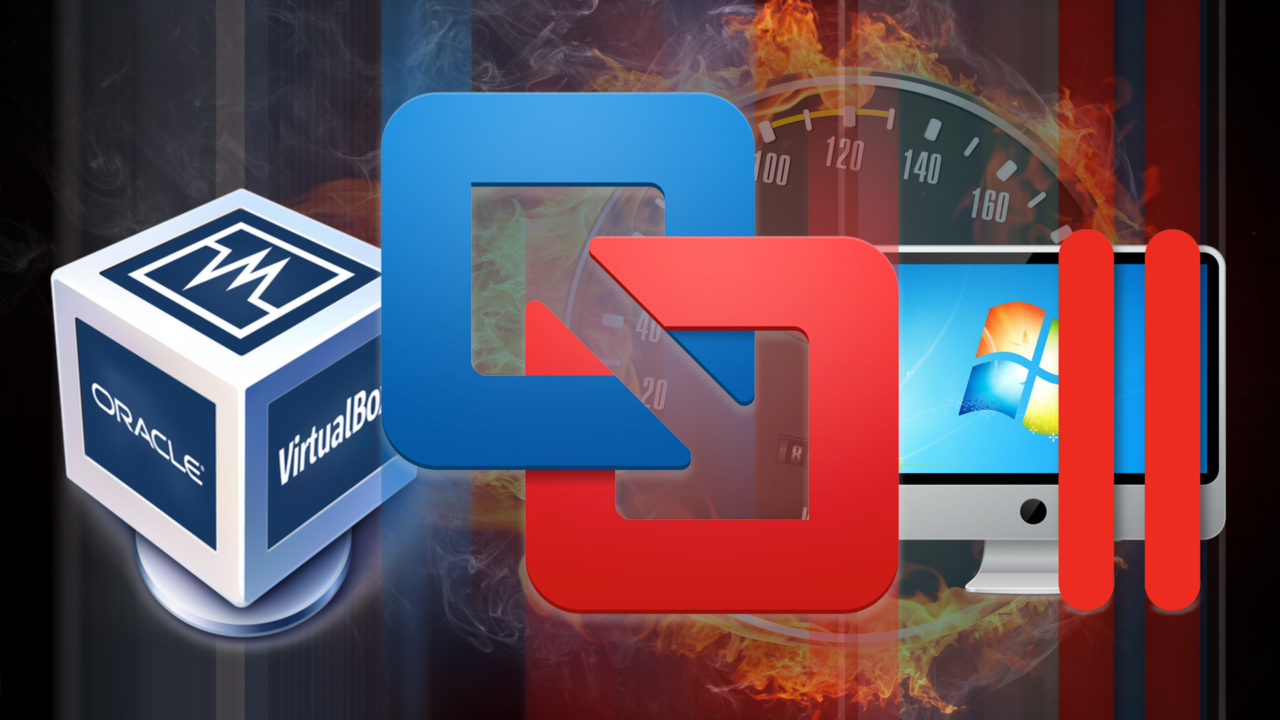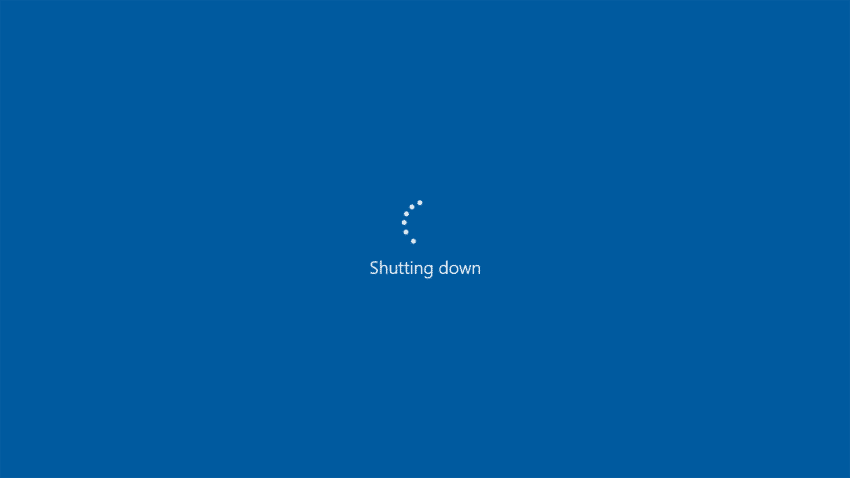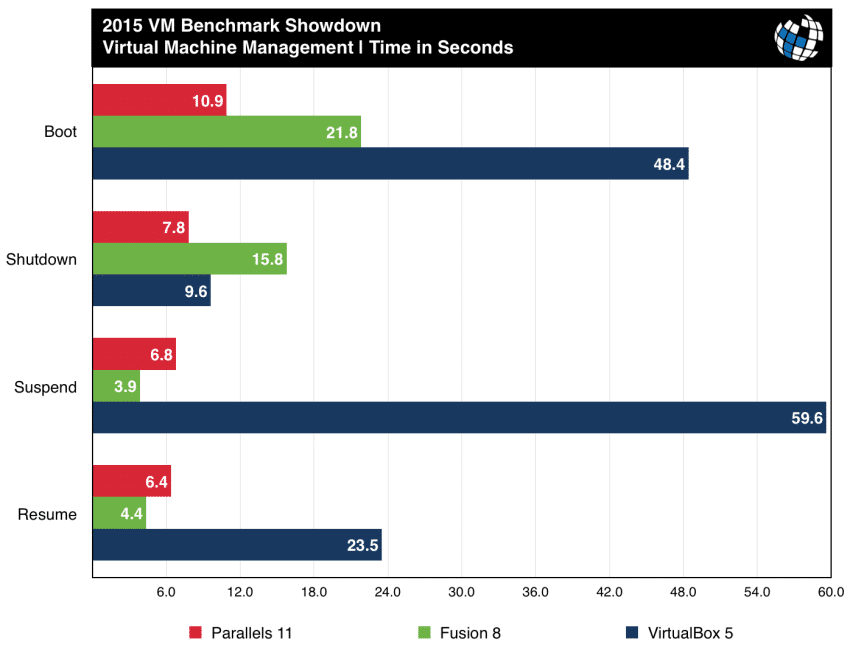2015 VM Benchmarks: Parallels 11 vs. Fusion 8 vs. VirtualBox 5


Virtual Machine Management
Next up in our Parallels 11 vs. Fusion 8 benchmarks is a look at virtual machine management. If you plan to use just a single virtual machine and leave it running most of the time, this section probably holds relatively little value for you. But for those users who frequently run or access lots of virtual machines, we wanted to see how Parallels, Fusion, and VirtualBox compare when it comes to boot, suspend, resume, and shut down times.
As with the earlier section for File Transfers, these tests were measured manually with a stop watch and conducted five times each. The numbers in the chart below represent seconds so, again, lower is better.
Once again, we see Parallels and Fusion trading places based on the type of activity. Parallels 11 boots Windows 10 insanely fast, in about 10 seconds, and can shut it down even quicker, at around 8 seconds. These speeds, which would seem ludicrous to a Windows user from a just a few years ago, are a product of both Parallels’ efficiency at handling boots and shutdowns, and also Microsoft’s efforts, begun with Windows 8 and continuing in Windows 10, to significantly improve boot times.
When it comes to suspend and resume functions, however, Fusion is the champ, and can get you up and running again in a suspended VM in just over 4 seconds. VirtualBox, for its part, really underscores the adage “you get what you pay for,” and takes a frustratingly long time to boot, suspend, and resume its virtual machines, with the only bright spot being a respectable second-place finish in shutdown times.
While Parallels’ fast boot times or VirtualBox’s minute-long suspend times may be noteworthy enough to sway a consumer towards (or away from) one product or another, remember that these factors only make a big difference if you use multiple virtual machines throughout the day and need to shut down or suspend one, and then boot or resume another, as quickly as possible. If you only use a single VM, booting it in the morning and suspending it at night, you may not want to shell out for Parallels or Fusion if, for example, VirtualBox’s other performance limitations aren’t a problem for you. Taking that course will save you between $50 and $80, which is a hefty price to otherwise pay for an extra minute of waiting while you suspend your VirtualBox VM.
Finally, note that, like our file transfer tests, these boot numbers are based on expected performance from a modern Mac CPU and fast flash storage. If you have an older Mac, or otherwise store your virtual machines on mechanical hard drives, you’ll see longer times for the tests above.
Table of Contents
[one_half padding=”0 5px 20px 0″]
1. Introduction
2. Test Setup & Methodology
3. Geekbench
4. 3DMark
5. FurMark OpenGL
6. Cinebench R15
7. PCMark 8
8. Passmark PerformanceTest
[/one_half]
[one_half_last padding=”0 0px 20px 5px”]
9. Video Encoding
10. File Transfers
11. USB 3.0 Speed
12. Virtual Machine Management
13. Battery Life
14. Mac Pro: Gaming
15. Mac Pro: CPU
16. Conclusions
[/one_half_last]



















28 thoughts on “2015 VM Benchmarks: Parallels 11 vs. Fusion 8 vs. VirtualBox 5”
* ESXi with macOS guest
Has anyone else notices that Fusion runs a bit “hotter” than Parallels? I find that opening up Fusion to Win 7 or Win 10 automatically gets the temp up at least 20 degrees (F) or so on my rMBP (2015) set for 2 of 4 cores and 8 of 16 gigs of the RAM allocated. This is very disappointing. I have zero issue with the VMware offering (used it years ago) save for this need to use more energy than Parallels. I only use Windows for a couple of apps but I would be worried about adding a more CPU intensive app if heat is generated like this at a greater scale.
Any thoughts or confirmation of Fusion running hotter?
On my current setup it seems to take an eternity for the memory on my Windows VM to be filled with all the data it needs (I need to have a SQL server and a related application running on my Windows OS). Are there any good metrics on how long it takes for the OS to load up files from the drive into memory?
PS: Hard drive is a traditional drive, system report describes as APPLE HDD ST1000DM003
1) The exact models and specifications for the testing hardware are listed in the article, along with the methodology used for the tests. You’ll find this information on the ironically named “Test Setup & Methodology” page.
2) We submitted our results and methodology to both Parallels and VMware to give each company a chance to respond. Neither company claimed that our testing procedure or the configuration of our virtual machines were incorrect or unfair.
3) Other than providing licenses for both Fusion 8 and Parallels Desktop 11 for our tests, TekRevue was not remunerated by either company in any way, nor were the tests conducted or guided by anyone outside of TekRevue.
4) These products, and our review, are primarily targeted at consumers. That’s why we used both a MacBook Pro and mid-level Mac Pro in the tests. If you’d like us to conduct future tests on your custom Mac Pro (I say “custom” because the Mac Pro you describe in your other comment — 2 x 6-core hyperthreaded 3.33GHz — is not a configuration Apple ever shipped), then please send it to us and we’ll be happy to do the additional testing. In general, however, I hope you’ll agree that your specific configuration isn’t applicable to ~99% of users.
I didn’t try any hard-core games, as I don’t use the machine for that purpose. However, multiple version of Windows (XP, 7, 10) ran faster and smoother overall in Parallels for general use in my experience.
Having said that, I had some trouble with Parallels recognizing certain USB devices that Fusion did not have trouble with. Complained about it to Parallels, and they’ve recently pushed out a new release that addressed and fix those problems, so I appreciate their customer support.
Good article, thanks!
VM Capabilities
VM Capabilities
You are forgetting one major thing: Fusion and Parallels are designed to integrate Windows with OS X. VirtualBox is designed to virtualise an entire machine as if it were 100% separate, no integration at all.
It would be worth seeing how Parallels & Fusion (or even Virtualbox, but I assume it’ll look absolutely terrible as far as performance goes) similarly act under a multi-chip host environment to see how they negotiate allocations between multiple physical chips, as opposed to threads all being sent to the same chip.
I’m an enthusiast of fusion 8 and a user fro version 5. This last release is a great goal!
Overall content on Tekrevue is very solid. I enjoy reading OS X tips mostly.
Thanks guys!:)